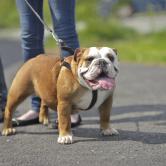Should You Consider a Harness for Your Bulldog?

Combine the size and strength of this breed with its energy and excitable personality and you have a challenge on your hands. Bulldogs are notorious for becoming overly excited on walks and that often leads them to pull on the leash. If your Bulldog has developed this tendency you may be wondering what you can do to fix it. The solution may be as easy as switching to a harness – keep reading to learn more.
What Are the Benefits of a Harness?
Most dog owners fit their dogs for a collar and then they buy a matching leash. In many cases, this is perfectly fine but some dogs need a little extra help when it comes to walking on a leash. Dogs like the Bulldog in particular have an affinity for pulling on the leash which can make your daily walk a little more challenging. If you’re looking for a better way, consider switching from a regular collar to a harness – here are the pros and cons of dog harnesses:
Pros for Dog Harnesses
· A harness takes some of the strain off your dog’s neck and distributes it safely across his back.
· Harnesses help to prevent injuries to the trachea and neck resulting from pulling on the leash.
· A harness may give the owner greater control over his dog during a walk, especially for large breed dogs.
Cons for Dog Harnesses
· A harness may not solve behavioral issues like extreme pulling, jumping, or aggression.
· Some dogs are uncomfortable wearing a harness, though many get used to it over time.
· The dog might be able to slip out of the harness if it isn’t tightened and worn correctly.
Tips for Choosing a Harness
When shopping around for a harness for your Bulldog, there are several things to consider. First of all, you want to purchase a harness that is the right size and weight for your dog. Most dog harnesses are adjustable to a certain degree, but you’ll still need to choose the right size for your dog – it may help for you to take a measurement around your dog’s chest and back for proper sizing. Next, think about attachment points – harnesses clip either in the back, in the front, or there is a D-ring for both points. Front-clipping harnesses can help you to curb leash pulling a little more effectively than back-clipping harnesses but some dog owners still prefer the original. Finally, you want to choose a harness made from durable materials so it will last for a while, or at least until your dog grows out of it.
If your Bulldog has a tendency to pull on his leash, switching from a traditional collar to a harness might be the most effective (as well as the simplest) solution. When using a harness, be sure to follow the instructions carefully to learn how to put it on your dog and then adjust the sizing so it is snug but not too tight. Then, all you have to do is test it out by taking your dog for a walk!
Photo credit: Tatiana Katsai/Shutterstock







